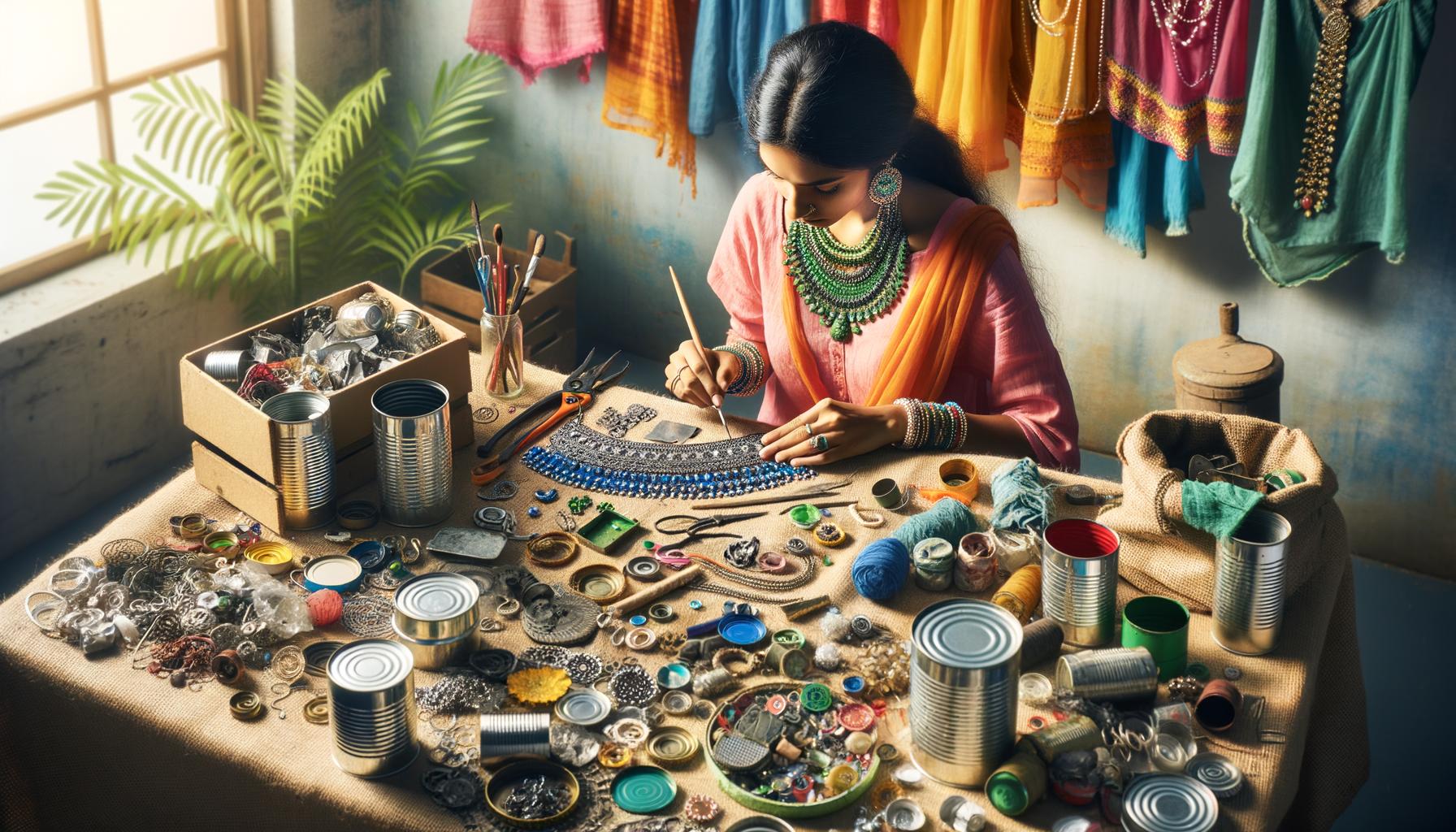Creating jewelry with recycled materials: a sustainable approach has become increasingly popular as eco-conscious consumers seek alternatives to traditional fashion practices. The demand for sustainable products spans across various industries, including the jewelry sector, where environmental and ethical concerns are paramount. As awareness grows about the impact of conventional mining and resource extraction on our planet, both designers and consumers are exploring innovative ways to craft beautiful accessories without compromising ecological integrity.
In recent years, sustainable fashion has evolved from a niche market to a mainstream movement. People are reevaluating their purchasing habits and looking towards brands that prioritize eco-friendly methods. Jewelry, often considered a luxury item, is not exempt from this scrutiny. The industry’s reliance on precious metals and gemstones poses significant environmental challenges, such as habitat destruction and pollution from mining activities. Consequently, there is an urgent need for more responsible approaches in jewelry making.
One promising solution lies in the practice of creating jewelry with recycled materials. By repurposing existing resources like metals, plastics, fabrics, and other discarded items into stunning pieces of wearable art, designers can significantly reduce their environmental footprint while also offering unique and meaningful products. This approach not only conserves natural resources but also inspires innovation within the industry, opening new avenues for creativity and sustainability in design.
Understanding Recycled Materials in Jewelry Making
Creating jewelry with recycled materials: a sustainable approach starts with understanding what comprises recycled materials in the context of jewelry making. Recycled materials are essentially post-consumer waste or by-products that are repurposed to create new items, transforming potential trash into treasure.
These materials can come in various forms, including metals, plastics, fabrics, and even organic substances like wood or shell. The appeal of these materials lies not only in their eco-friendly nature but also in their unique aesthetic qualities that add distinctive character to jewelry pieces.
One of the most common types of recycled materials used in jewelry is metals. Metals such as silver, gold, and aluminum are particularly valued because they can be endlessly recycled without losing their inherent properties.
For example, recycled silver can be sourced from discarded electronics or photographic waste and repurposed into beautiful jewelry without degrading its quality. Plastics also present fascinating possibilities; PET bottles and discarded acrylics, which would otherwise clutter landfills for centuries, can be transformed into vibrant beads or intricate components for statement pieces.
Fabric scraps and old textiles offer another realm of creative potential. Turning remnants from fashion manufacturing or worn-out clothing into wearable art not only reduces fabric waste but also allows for the preservation of textile heritage through innovative designs.
Organic materials like wood and shells provide a tactile connection to nature and often lead to the creation of earthy, bohemian-style pieces. Each material comes with its own set of advantages and challenges, thus broadening the scope for designers looking to adopt creating jewelry with recycled materials: a sustainable approach.
| Recycled Material | Source | Application |
|---|---|---|
| Silver | Discarded electronics | Rings, necklaces |
| PET Plastics | Bottles | Beads, pendants |
| Fabric Scraps | Leftover textile industry fabric | Earrings, brooches |
These different types of recycled materials bring an element of sustainability while offering diverse design possibilities that may not be feasible with conventional resources. Educating oneself on the sources and properties of these materials empowers designers to make informed choices that positively impact both style and environmental stewardship. With growing awareness around ecological issues, using such innovative methods is crucial in reshaping how we perceive luxury and craftsmanship within the jewelry industry.
Environmental Impact and Benefits
Creating jewelry with recycled materials: a sustainable approach, holds significant environmental benefits that are pivotal in the fight against climate change and ecological destruction. One major advantage of this practice is the substantial reduction in waste and pollution.
Traditional jewelry production often involves mining for metals and gemstones, which generates a considerable amount of waste rock, tailings, and debris that can harm natural landscapes. Conversely, by repurposing old jewelry, electronics, or everyday items like PET bottles and fabric scraps, designers can divert these materials from landfills and waterways.
Energy savings also play a crucial role in defining the efforts towards sustainability in jewelry making. Mining precious metals such as gold and silver not only damages ecosystems but also requires immense energy consumption that contributes significantly to greenhouse gas emissions. Utilizing recycled metals drastically cuts down on this energy usage.
Studies have shown that recycling aluminum saves up to 95% of the energy needed to produce new aluminum from raw ore. This massive reduction in energy requirement highlights how creating jewelry with reclaimed materials can considerably lower our carbon footprint.
Additionally, using recycled materials has profound positive impacts on wildlife conservation and ecosystem preservation. Mining operations often disrupt habitats leading to loss of biodiversity and negative effects on local flora and fauna populations. By choosing to craft with recycled materials like wood from sustainably-managed forests or shells collected responsibly without harming marine life, designers help protect these vital habitats. Furthermore, reducing reliance on newly mined resources alleviates some of the pressures exerted on already vulnerable ecosystems around the globe.
| Environmental Benefit | Details |
|---|---|
| Waste Reduction | Diversion of old jewelry, electronics, PET bottles from landfills |
| Energy Savings | Recycling saves up to 95% of energy compared to new production |
| Wildlife Conservation | Reduced habitat disruption by avoiding mining activities |
In sum, integrating eco-friendly practices through creating jewelry with recycled materials: a sustainable approach stands as one powerful method for individuals within the industry to actively reduce their environmental impact while cultivating innovative artistic expression.
Popular Recycled Materials and Their Sources
When it comes to creating jewelry with recycled materials: a sustainable approach, metals are among the most popular choices due to their versatility and durability. Recycled metals such as silver, gold, and aluminum can be sourced from various items like old electronics, discarded jewelry pieces, and industrial scrap.
These metals undergo a refining process that removes impurities and makes them suitable for crafting new pieces of jewelry. The use of recycled metals not only reduces the need for mining new resources but also lowers energy consumption during production.
Plastics also offer an innovative avenue for sustainable jewelry-making. Common sources include PET bottles, food containers, and discarded acrylics. By recycling these plastics, artisans can produce beads, pendants, and other decorative elements that mimic the appearance of more traditional materials.
PET bottles can be chemically treated to form durable plastic sheets or pellets which are then molded into different shapes. This transformation process helps divert tons of plastic waste from landfills and oceans while offering a creative material choice for eco-conscious jewelry designers.
Organic materials such as wood and shells add a natural touch to sustainable jewelry designs. Wood scraps from furniture factories or construction sites can be repurposed into elegant beads or carved into intricate designs. Similarly, shells collected from beaches (ensuring they are not taken from protected environments) provide unique textures and colors that enhance the aesthetic appeal of handcrafted pieces.
Textile scraps present another exciting opportunity for creating stunning recycled jewelry. Leftover fabrics from fashion houses or old garments can be cut into strips or patches to create fabric-based accessories like necklaces or bracelets.
Sourcing these materials:
- Metals: Old electronics, discarded jewelry pieces
- Plastics: PET bottles, food containers
- Organic Materials: Wood scraps from construction sites
- Textiles: Fabric scraps from fashion houses
This sourcing not only promotes sustainability but also highlights the beauty in reusing what would otherwise contribute to environmental pollution.
Techniques and Tools for Crafting Recycled Jewelry
Crafting recycled jewelry requires an understanding of various techniques and tools that are uniquely suited to handle the diverse nature of repurposed materials. One common method is cold connection, which involves joining components without using heat. Techniques such as riveting or using screw rivets provide sturdy connections for different types of metals and plastics without altering their properties. Cold connection is particularly useful when working with mixed media, allowing artists to combine metal with fabric or found objects seamlessly.
Another indispensable technique in creating jewelry with recycled materials: a sustainable approach, is wire wrapping. This method involves bending and twisting wires to form intricate structures or secure elements together. Wire wrapping can be used across a vast range of materials, from old electrical wires to discarded metal strips.
When working with organic materials like wood or shells, this method allows flexibility while maintaining firmness and aesthetic appeal. To enhance creativity, jewelry makers can hammer the wires for texture or patina them for added color variations.
Essential tools play a crucial role in shaping and assembling recycled jewelry pieces. Standard tools such as pliers (flat-nose, round-nose, chain-nose), cutting tools (snips, saw blades), and files help manipulate metals precisely and efficiently. For plastics and fabrics, additional tools like hot glue guns or sewing needles might be needed.
It’s also beneficial to keep an array of sandpapers handy to smooth out rough edges on various recycled materials. Sourcing these materials calls for an innovative mindset; everything from garage sales to thrift stores offers potential treasures waiting to be transformed.
Overall, success in crafting recycled jewelry hinges on mastering these basic techniques while experimenting fearlessly with different combinations of repurposed items. Whether through cold connections or wire wrapping, the possibilities are endless when it comes to transforming everyday waste into stunning artistic statements.
Design Inspiration and Creativity
Showcasing Innovative and Unique Designs From Recycled Materials
The world of sustainable fashion is brimming with creativity, especially when it comes to designing jewelry with recycled materials. Designers worldwide are pushing the boundaries by transforming discarded items into stunning pieces of wearable art.
For instance, old vinyl records are being repurposed into bold statement earrings, while fragments of broken ceramic dishes find new life as delicate pendants. Creating jewelry with recycled materials: a sustainable approach not only breathes new life into what would otherwise be waste but also opens up a realm of unique design possibilities that can’t be replicated with new materials.
Strategies for Combining Different Materials to Create Stunning Pieces
One hallmark of successful sustainable jewelry design is the innovative fusion of varied recycled elements. Woven fabric scraps can be intertwined with metal chains salvaged from old accessories to create textured bracelets that tell a story of their past lives.
Similarly, blending polished wood pieces with sleek aluminum captured from soda cans can result in eye-catching necklaces that combine rustic and modern aesthetics. Playing with texture, color, and form when combining different recycled materials allows for endless artistic expression and ensures that each piece remains one-of-a-kind.
Highlighting Successful Designers and Brands Leading This Movement
Several visionary designers and brands have set the standard for creating exquisite jewelry using only recycled materials. For example, emerging brand “Revive Jewelry” sources all its metals from electronic waste, crafting contemporary rings and necklaces while simultaneously mitigating environmental damage caused by e-waste disposal.
Another trailblazer is “EcoChic Creations,” which has built a reputation on transforming discarded plastic bottles into vibrant beads used in their bohemian-inspired jewelry line. By championing eco-friendly practices and marrying them with high-quality craftsmanship, these leaders inspire others to adopt a more sustainable approach in their creative endeavors.
Case Studies
Reinvention by Melissa Joy Manning
Melissa Joy Manning is a notable name in the world of sustainable jewelry. Her brand has garnered attention for its profound commitment to eco-friendly practices and creating jewelry with recycled materials: a sustainable approach. Utilizing recycled precious metals like gold and silver, she crafts stunning pieces that speak volumes about sustainability and elegance.
Recognizing the prevalent wastefulness in mining new materials, her practice significantly reduces the environmental footprint. By meticulously sourcing reclaimed metals and vintage stones, Melissa Joy Manning not only helps preserve natural resources but also showcases how luxurious recycled jewelry can be.
The Eco-Centric Designs of Bario Neal
Another pioneer in sustainable jewelry is Bario Neal, a company celebrated for integrating ethical sourcing into their creations. Their designs frequently feature recycled precious metals and ethically-sourced gemstones. By emphasizing transparency and advocating fair trade practices, Bario Neal sets an industry standard for responsible jewelry-making.
The success of their approach lies in their commitment to reducing waste and promoting recycling efforts within their supply chain. Notably, the brand has managed to create exquisite collections that appeal aesthetically while reinforcing the critical narrative of sustainability in fashion.
Elegance Redefined by Soko
Soko stands as a compelling example of how sustainable jewelry can support community development while being stylishly unique. This Kenya-based brand thrives on creating modern pieces using locally sourced, environmentally friendly materials such as reclaimed brass. By employing local artisans who handcraft each piece, Soko ensures that traditional techniques are preserved while promoting fair wages and ethical labor practices.
The combination of cultural heritage with contemporary design exemplifies how creating jewelry with recycled materials: a sustainable approach can foster economic growth alongside environmental responsibility. These case studies collectively highlight various paths to achieving success through sustainability-driven innovation in jewelry making.
Marketing Your Sustainable Jewelry
In the world of modern commerce, having an eco-conscious brand identity is not only a trend but a necessity for standing out in a competitive market. To build a successful brand around creating jewelry with recycled materials: a sustainable approach, it’s crucial to emphasize your commitment to environmental stewardship.
Start with storytelling-let customers know the journey behind each piece, from sourcing recycled materials to the craftsmanship involved in transforming these materials into beautiful jewelry. Transparency builds trust and highlights the uniqueness of your creations.
Effective marketing involves leveraging multiple platforms to reach your target audience. Social media is an invaluable tool for showcasing your designs and sharing behind-the-scenes content that emphasizes your sustainable practices.
Platforms such as Instagram and Pinterest are visual-centric and perfect for displaying high-quality images or videos of your pieces, while Facebook groups can help foster community discussions around sustainability in fashion. Hashtags like #SustainableJewelry and #EcoFriendlyFashion can connect you with eco-conscious consumers searching for products that align with their values.
Another indispensable strategy is connecting with influencers who share a passion for sustainability. These partnerships can expose your brand to broader audiences who are already interested in eco-friendly lifestyles. Additionally, participating in eco-focused trade shows, craft fairs, and local markets can provide tangible experiences that forge deeper connections with customers. Utilizing these avenues not only garners more visibility but also helps build a loyal customer base dedicated to supporting environmentally responsible businesses like yours.
Lastly, consider offering certifications or badges on your website that verify the sustainability of your products, which could further instill buyer confidence. Collaborate with certifying bodies that focus on ethical fashion and recycled materials to add credibility and appeal to discerning shoppers committed to making an impact through their purchasing choices. Through intentional branding strategies and genuine engagement with the community, you’ll find success in marketing your sustainable jewelry and contributing positively to both the industry and environment.
Educational Resources and Communities
Exploring the world of creating jewelry with recycled materials: a sustainable approach can be both an enriching and inspiring journey. To help you along this path, there are numerous educational resources available that can provide you with valuable insights, techniques, and inspiration.
Books such as “The Jewelry Maker’s Field Guide” by Helen Driggs or “Upcycled Jewelry: Bags, Belts & More from Reclaimed Materials” by Linda Peterson are excellent starting points. These books not only cover technical aspects but also delve into sustainability practices essential for responsible crafting.
In addition to printed resources, online courses offer a flexible way to learn and perfect your craft at your own pace. Platforms like Udemy, Skillshare, and Coursera feature courses specifically focused on sustainable jewelry-making methods.
These courses often include video demonstrations, material lists, and even forums where you can ask questions and share your progress with instructors and fellow students. Websites like YouTube also host numerous DIY channels where experienced crafters post tutorials on how they create stunning pieces from everyday recycled objects.
Connecting with communities of like-minded individuals is another powerful avenue for growth and inspiration. Social media platforms such as Instagram and Pinterest serve as excellent venues for discovering innovative designs and following artists who specialize in sustainable creations.
Online forums like Reddit’s r/jewelrymaking or Facebook groups dedicated to eco-friendly artistry provide spaces for discussion, feedback, and advice-sharing. By engaging with these communities, you’ll gain access to a wealth of collective knowledge and experience that can significantly advance your skills in creating jewelry with recycled materials: a sustainable approach that resonates on many levels.
Lastly, attending workshops or joining local maker spaces offers hands-on experience that can’t be replicated online. Many cities host artisan markets or environmental fairs where you can meet other eco-friendly creators face-to-face, attend live demonstrations, and even participate in collaborative projects.
Maker spaces often have tools available that may not be feasible to purchase individually, allowing you to experiment without significant upfront investment. These environments foster creativity through shared learning experiences and open up opportunities for collaboration that could lead to innovative new products or business ventures within the sustainable jewelry realm.
Conclusion
As the fashion industry continues to embrace eco-friendly practices, creating jewelry with recycled materials: a sustainable approach has become more than just a trend-it’s a necessary evolution. This movement not only addresses critical environmental concerns but also opens up an exciting avenue for creative expression and innovation within the jewelry-making community.
By repurposing materials like metals, plastics, and textiles that would otherwise contribute to waste, designers are pioneering a new standard of sustainability that benefits both consumers and the planet.
Looking ahead, the future of sustainable jewelry shines brightly with promise. As awareness of climate change and environmental degradation grows, more consumers are seeking brands that align with their values of sustainability and conservation.
This shift provides immense opportunities for jewelers dedicated to eco-friendly practices to capture this burgeoning market. Additionally, advancements in technology and craftsmanship will likely lead to even better methods for sourcing and processing recycled materials, making it easier for artists to create high-quality pieces without compromising on their ethical standards.
For those aspiring to dive into this green revolution within the jewelry industry, there is no better time than now. With ample educational resources, vibrant communities of like-minded individuals, and successful examples lighting the way, anyone can start their journey towards sustainable jewelry-making.
Let’s not merely hope for a greener future; let’s craft it with our own hands by embracing recycled materials in our creations. Together, we can adorn this world beautifully while preserving its natural treasures for generations to come.
Frequently Asked Questions
Is Recycled Jewelry Sustainable?
Recycled jewelry is generally considered sustainable as it involves repurposing existing materials, reducing the need to extract new resources. This process helps minimize environmental impacts, such as habitat destruction and pollution associated with mining operations.
Furthermore, recycling metals and gemstones can significantly lower carbon footprints compared to sourcing raw materials. By giving a second life to old or unused jewelry items, not only is waste reduced, but consumers also have access to unique, one-of-a-kind pieces that often hold historical or sentimental value.
How Can We Make Jewelry Sustainable?
Making jewelry sustainable can be achieved through several practices focused on ethical and environmental responsibility. First, using recycled or responsibly sourced precious metals and gemstones reduces the ecological impact of mining activities. Implementing fair trade practices ensures that the workers involved in the production are fairly compensated and work under safe conditions.
Additionally, adopting eco-friendly manufacturing techniques and minimizing energy consumption can further enhance sustainability efforts. Educating consumers about sustainable choices also plays a critical role in driving demand for ethically-made jewelry.
What Is Sustainable Development in Jewellery?
Sustainable development in the jewelry industry refers to strategies that balance economic growth with social equity and environmental protection. This approach aims at producing jewelry in ways that do not exploit natural resources or labor forces while ensuring long-term viability and minimal environmental footprints.
Sustainable development emphasizes transparency throughout the supply chain, from extraction to production and sale, enabling consumers to make informed purchasing decisions that align with their values. Ultimately, it fosters an industry where craftsmanship respects both people and the planet, ensuring a responsible approach towards future generations.

Welcome to my jewelry blog! My name is Sarah and I am the owner of this blog.
I love making jewelry and sharing my creations with others.
So whether you’re someone who loves wearing jewelry yourself or simply enjoys learning about it, be sure to check out my blog for insightful posts on everything related to this exciting topic!





